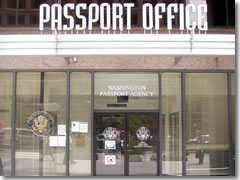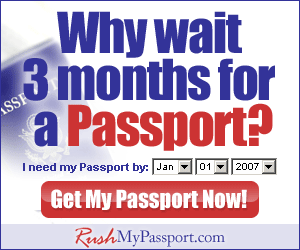Passports
The global ID card—and, technically, the only thing absolutely required for travel abroad

The passport office in Washington, DC (you can just mail in the forms, though.)When it comes down to it, you really only need three things to travel to a foreign country: (1) a plane ticket, (2) clothing, and (3) a passport. (Money also helps.)
A valid passport is the only legal form of identification recognized around the world. Your driver's license ain't gonna cut it out there— abroad, it only proves that some U.S. state lets you drive (though you will need that to rent a car).
"Almost expired" is the same as "expired"
Note that many countries will not let you in if your passport is set to expire within six months. If your passport is getting on in years and is due to expire within six months of your return to your home country, it's wisest to replace it with a new one before your trip.You cannot cross an international border without a passport. Well, OK, since 1997 you can criss-cross most of Western Europe without flashing it, but you still need it to get in, plus to go to Great Britain and Ireland (it's an insular thing), Switzerland (it's a neutrality thing), and most of Eastern Europe (it's a holdover-from-the-Iron-Curtain-days thing).
Getting a passport is easy—all it takes is two photos of yourself, some government forms, and $135—but it takes some time to complete the process.
Note
This pages details how to get a passport for U.S. citizens. If you hail from another country, use embassyworld.com to find the site of your local equivalent to the State Department or Foreign Office to get the details.Make sure you start the paperwork at least six to ten weeks in advance of your departure. It'll probably only take 3-4 weeks (and there are ways to expedite it—for a fee), but don't tempt fate.
This process involves showing up in person at a Passport Acceptance Facility (which includes many major post offices, some libraries, courthouses, and other government buildings; the list is at travel.state.gov). You cannot simply apply for a passport by mail.
Since all the current details on how to apply for a passport are so readily available on-line, there's little reason for me to rehash it all here—just go to the excellent State Department site (travel.state.gov) and it'll walk you through the process. But here are a few useful pointers:
In addition to a passport, and possibly an entry visa, some countries may ask for the following:
• A local address in the country (just have the name/location of your first hotel ready)
• An ongoing ticket (proof you're going to leave the country)
• Proof that you have money (credit cards and an ATM card should do)
- You'll need two identical passport-size photos (2" X 2"), which you can have taken at any photo shop or most major chain drug stores. You cannot use the strip of pictures from one of those photo vending machines. Go ahead six to eight total made up. You'll need extras to apply for an International Driving Permit, student or teacher identification cards, and travel visas to some countries. Take the rest of the photos with you. You'll occasionally need one for random reasons (such as London's Travelcard) on the road and—heaven forbid—if you ever lose your passport, you can use one as a replacement photo.
- You'll need to bring proof of U.S. Citizenship. This usually means a previous passport or a certified birth certificate with both parent's full names (not a photocopy, but a certified copy and a registrar's seal—usually raised or embossed—and signature; you can order one from the state in which you were born). If you are a citizen but were not born in the U.S., you can bring a Consular Report of Birth Abroad, a Certification of Birth, a Naturalization Certificate, or a Certificate of Citizenship. Note you must also bring a photo ID, so if you don't have an old passport, you must bring a driver's license or equivalent (military ID or other government-issued photo ID) Exit fees
- When you go to apply for your passport, bring two checks. For reasons known only to the federal bureaucracy, you have to fill out two separate checks (one is an Application Fee, the other an Execution Fee). Silly? Of course. Still, its impossible to argue with the federal government: just bring two checks.
- You'll be given a choice of a Passport Book, and Passport Card, or both. What you want is the "Passport Book." This is the traditional, old school passport. The "Passport Card" was essentially designed as a low-cost alternative ($55 versus $135) for truckers and others whose business constantly takes them back and forth across the border with Mexico or Canada (though it is also valid for Bermuda and most Caribbean countries, so it is used by some cruisers and snowbirds who don't bother traveling anywhere else). You cannot use a Passport Card to go to Europe, Asia, South America, Africa, or anywhere else besides the U.S., Canada, Mexico, and the Caribbean. It is, therefore, pretty pointless.
- What if I need a passport in a hurry?
You can get an expedited passport in as little as 24 hours—if you're willing to pay for it. Services like our partner RushMyPassport.com (www.rushmypassport.com) can get you a new passport, or renew an old one, quickly for an expedite fee, which goes up depending on how soon you need it:
• 8–12 business days - $99
• 5–7 business days - $149
• 3–4 business days - $199
• 2 business days - $249
• 1 business day - $299
Note that those prices are just for the fast service; you still have to pay the government fees for the passport itself.It can take up to 10 weeks to get your passport. That's all the government will promise (actually, they don't even promise that; they simply state it as a ballpark). In practice, it usually only takes about 4–6 weeks (I once got a renewal passport just two weeks after dropping off the forms), but don't count on it arriving sooner than 10 weeks. There are three ways to get it faster:
- You can pay the government a $60 expedite fee and they'll try to get the passport to you in 2–3 weeks.
- You can pay for an expedite service like RushMyPassport.com
(see to the box on the right), where fees start at $99 to get a passport in 8–12 business days (up to $299 for 24-hour service).
- If if is a life-or-death emergency, the government can get you a passport in 24–48 hours, but you have to apply in person at a Passport Agency (there are only 25 of those in the country) and bring poof of the emergency.
- Make three photocopies of your passport (the open page with all the personal data, not the cover). This is the main item on your backup info sheet (along with other IDs, the numbers to call if you lose your credit cards, etc.). Keep one copy with you at all times—separate from the original—another copy hidden in your bag somewhere, and leave the third copy at home with a trusted friend or neighbor who can fax it to you in case of emergency.

- Keep your passport with you at all times securely in your money belt. The only times to give it up are at the bank for the tellers to photocopy when they change your traveler's checks, at borders for the guards to peruse (this includes giving it to the conductor on overnight train rides), when any police or military personnel ask for it, and briefly to the concierge when you're checking into your hotel (see next).
- Hotel front desks, especially in southern Europe, will often want to keep your passport overnight. They have to register you with the police, and they like to pile all the passports in a drawer until the evening so they can do all the guests' slips at once. Smile and ask politely whether they can do their paperwork on the spot or at least let you come by in 15 minutes or so, after you check into your room, freshen up, and are on your way out to hit the town. I always tell them I need it to go exchange money at the bank, whether I'm flush with cash or not.
- Consulate or Embassy?
As a foreigner abroad you will always deal with your country's local consulate, never your country's embassy.
Embassies are for your government to deal with their government, so unless you are a diplomat (or seriously well-connected), you will never be inside one.
Consulates, on the other hand, provide services to its own citizens in a foreign country (mostly tourists, business types, and citizens living abroad).
Yes, in a given capital city, your home consulate will likely in an annex of your home embassy. However, the consulate is maintained as a separate section (an ID and an appointment—or loooong wait—will get you into your home consulate; burly Marines will keep you from ever getting into the embassy), and while there is only one embassy there are often multiple consulate, one in each major city.If you lose your passport on the road, go directly to the nearest U.S. consulate (usembassy.state.gov). Do not pass go, do not collect €200. Bring all forms of identification you have, and they'll get started on generating you a new passport. Needless to say, this is a hassle that should be avoided at all costs. Again: carry your passport in a moneybelt at all times.
Some countries charge an exit fee when you fly out. This can range from $20 to $100—and is often cash-only. Be prepared by reading up on the requirements at travel.state.gov before leaving home.
Resources
U.S. State Department - This Web site is the best thing the government has ever done for travelers. You can download passport applications, research potential visa requirements, read consular fact sheets and travel warnings on the countries you wish to visit, and find out all about the services available to US citizens abroad. Great set of links to other governmental and non-governmental travel sites, too.
Embassy World - A nifty little Web site that links you to every embassy and consulate Web site out there, so an Aussie can find not only the Australian consulate in Rome, Italy, but also Italy's consulate in Canberra so he can ring up about visa requirements.
U.S. Embassies - Direct links to individual U.S. Embassy Web sites around the globe.
Related Articles |
Related Partners |
This article was by Reid Bramblett and last updated in April 2011.
All information was accurate at the time.
Copyright © 1998–2013 by Reid Bramblett. Author: Reid Bramblett.


